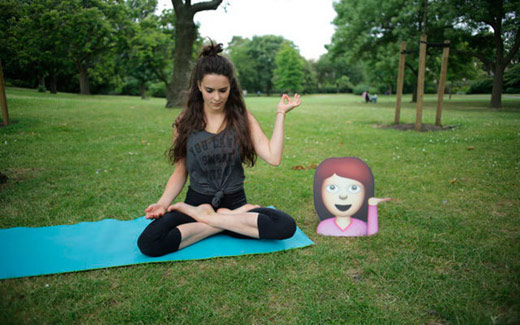當前位置: Language Tips> 英語學習專欄
分享到
2013年,emoji一詞正式入駐牛津在線詞典,人們才驚覺這小小的表情符竟能如此造勢。emoji貼紙,emoji衣服,emoji瑜伽……似乎一切和emoji掛鉤的事物變得時尚有趣起來,除此之外,emoji也給一些古靈精怪的人帶來了很多新奇的體驗——從前,有個人決定只吃emoji里才有的食物,然后她……從前,有對情侶整整一個月只用emoji交流,結果他們……而這次,為了探究emoji能否取代文字的地位,作者也要充當小白鼠去嘗試只用emoji聊天的生活了,不知道會有什么狀況等著她呢?

By Caroline Moss
柒月 選注
Emoji—A small digital image or icon used to express an idea, emotion, etc. in electronic communications. Emoji are everywhere. The little illustrated characters that are on smartphone keyboards are taking over the world. There are shoes with emoji on them, pants with emoji on them, emoji stickers, emoji yoga , and the list goes on and on with no sign of ending. As emoji spreads into our culture, I’ve actually heard the following question: Is emoji moving to replace communicating with the written word?
To find out, I communicated via iMessage using only emoji for five days. That meant every time someone sent me a text or I wanted to send a text, I could only use the popular tiny picture characters to respond to or start a conversation.
I wasn’t allowed to cheat by moving the conversation to Facebook or Twitter, etc., but I could send a phone emoji to indicate to the recipient of my texts that they could call me instead; I could not instigate the phone call myself. I wanted to see if it was easier or harder than I expected it to be, yes, but I also wanted to see if I could influence those I was conversing with to overthrow their use of text and start using emoji while talking to me.
Communicating with emoji was way more difficult than I expected it to be. There were people who were annoyed with me. There were people who gave up after a few back-and-forths. There were missed messages, mixed messages, and messed up plans. There were people who immediately just called my phone to get the conversation moving faster. And there was my mother who doesn’t have an iPhone and texts me often.
The first person to text me was my colleague Alyson Shontell. She knew the experiment was happening so made a large effort to stump me with hard questions that, to be fair, no one would ever ask me via text, like “where were you born again?” She was in the room with me when she sent it, so I was able to roll my eyes at her.
Earlier in 2014, Atlantic writer Kelsey Rexroat embarked on a week of only eating foods immortalized by emoji. Then there was the case of Alex Goldmark and his girlfriend Liza, who decided that for 30 days they would only use emoji when communicating via their phones. Goldmark and his girlfriend explained there was an instance where plans had to be changed last minute, but Goldmark misunderstood what Liza was trying to convey to him via emoji.
This happened to me when I was trying to explain to my friend Tom that I had booked both of our tickets for a destination wedding in several months. In turn, Tom thought I got a raise .
There were very few glimmers of hope throughout this experiment, and I cherished all of them. It wasn’t always terrible, for sometimes people seemed to understand what I was trying to tell them. Take my college friend Rachel, for example, who was taking a bus from Boston to visit me in New York. We communicated via text briefly—and flawlessly .
My experiment wasn’t as controlled as Goldmark’s experiment with his girlfriend Liza. Instead of just altering one relationship by extensively editing my means of communication with just one person, I spread the idea across my entire social circle, the trade off being that transactions of conversation were much more shallow. One thing I agreed with while listening and reading Goldmark’s findings was that he and Liza felt that emotions were easier to communicate using emoji, whereas logistics—plans, questions—were not. And unlike Rexroat’s awesome “only eating food found in emoji” experiment, I really set out to find if replacing the written word was plausible.
The truth? It’s probably not going to happen. Emoji is better as a form of punctuation . It adds flair to otherwise normal, and boring statements in a way that a period, exclamation point, or question mark never could.
One of the most charming elements of emoji is that, while every emoji has a technical official definition, people use them to represent different things. Quite simply, it’s a language that’s more subjective than objective. It became very clear early on that it would never replace the written word, unless as a civilization we were able to come together and assign very specific meanings to each picture that could, under no circumstance, be changed.
Vocabulary
1. emoji yoga: emoji瑜伽,又稱emoga,是由倫敦女孩Charlotte Bell創(chuàng)造的與emoji表情相結合的瑜伽動作。
2. instigate: 鼓動,教唆。
3. overthrow: 打倒,推翻。
4. 對于我發(fā)的信息,他們有時沒有注意到或者理解錯誤,有些計劃也會因此搞砸。missed: 沒有注意的;mixed: 混淆的,弄錯的;messed up: 搞砸的。
5. stump: 把……難倒,使挫敗。
6. roll one’s eyes at: 對……翻白眼。
7. 此前,在2014年,《大西洋月刊》作家Kelsey Rexroat用一周的時間只吃emoji上才有的食物。embark on: 開始,著手做……;immortalize: 使不朽。
8. get a raise: 得到加薪。
9. 在這個試驗過程中,只有極少數(shù)時刻讓我看到了希望,我對此倍加珍惜。glimmer: 閃光,微光。
10. flawlessly: 完美無瑕地。
11. 我并非只和一個人用這種方式交流,而是把這個點子擴展到了我的整個社交圈。相比文字來說,這種交流方式要更加淺顯。edit: 修改,改寫;trade off: 交換(這里指用emoji表情替換文字);transaction: 處理,執(zhí)行;shallow: 淺層的,膚淺的。
12. set out to: 開始;plausible: 似乎可信的。
13. punctuation: 標點符號。
14. 它(emoji)為那些平淡無奇的表達增添了吸引力,這是句點、感嘆號或者問號永遠不可能做到的。flair: <口>時髦,瀟灑。
15. assign: 指定,分配;specific: 特定的,明確的;under no circumstance: 絕不。
(來源:英語學習雜志 編輯:丹妮)
上一篇 : 與蝶共舞
下一篇 : 重拾經(jīng)典
分享到
關注和訂閱


翻譯
關于我們 | 聯(lián)系方式 | 招聘信息
電話:8610-84883645
傳真:8610-84883500
Email: languagetips@chinadaily.com.cn